 |
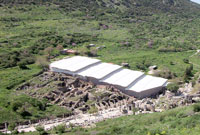 |
|
THE HALL OF TERRACE HOUSES
Many Roman period household items that have been found in the excavations carried out at the Terrace Houses for the last 50 years are exhibited in the first hall of the Ephesus Museum. On the left the plans of the houses and in the showcase the item related with cosmetics and medicine are displayed. |
|
| In the second showcase household utensils are exhibited. The glass tray is one of the most interesting item of all these. Just opposite the entrance the statue of the hunter Artemis stands in a niche and on the left the fresco of Socrates, which is one of the few fresco portraits of Socrates found throughout the world, can be seen. |
|
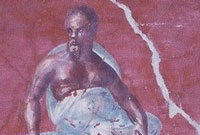 |
|
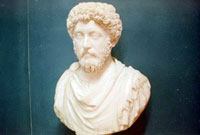 |
|
On the right of the hall the bust of Emperor Marcus Aurelius and statues of god Bess, god of fertility, are displayed. Three of the most important artifacts displayed in the museum can be seen in the middle section of this hall. These are Eros and the Dolphin (A.D. 2nd century), bronze statuette of Egyptian priest and famous Eros head by Lysippos. |
|
| THE HALL OF THE FOUNTAIN RELICS
In this hall the sculptures excavated from the monumental fountains of Ephesus such as Pollio, Trajan and Laecanus are exhibited. On the left the statue of Aphrodite with her ideal proportions reflects the ideals of beauty even today and the bust of Zeus stand. In the middle of the hall lies the statue of the Resting Warrior. |
|
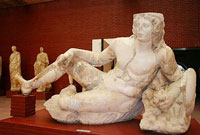 |
|
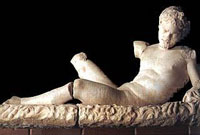 |
|
On the left the Polyphemos statue group that adorns the Fountain of Pollio can be seen. On the right are the remains from the Fountain of Trajan. Among these, the naked statuette of Dionysus leaning on a trunk, a statue of Styre, a statue of Aphrodite holding an oyster on her belly and Androclos and his dog. Also on the right are the statues of the Nymph and Triton from the Fountain of Lacaenus Bassus. |
|
| THE HALL OF THE RECENTLY FOUND ARTIFACTS
The artifacts obtained during the excavations have been exhibited in this hall for two years. On the right hand side of the entrance the Byzantine artifacts are displayed. On the right of the hall coins and other valuables are exhibited. Until the Roman era the bee, the symbol of Ephesus
and the sacred deer of Artemis were depicted |
|
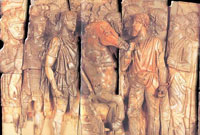 |
|
|
on the front and backsides of the Ephesians coins. During the Roman period on the front sides of the coins the emperors and their relatives and their attributes were depicted. The masks hanging on the wall were found at the theatre. |
|
 |
|
The masks used during the
performances were made of leather and wood. These stone made
masks were used for decoration only. On the same wall the production of candles are also shown in drawings. Eros with masks, amphoras, Eros figurines, statue of Aphrodite, the bust of the comedy writer Menander are the important items of the hall. The unique ivory frieze found at terrace houses depicts Emperor Trajan's war against the barbarians. |
|
| THE GARDEN
In the Mediterranean climate of the Aegean basin, gardens and courtyards have always played an important role in traditional architecture. Because of this, a garden was designed to give visitors a place to rest and refresh themselves especially during the hot summer months.
In the right hand side of the garden located behind the
museum, items such as sarcophagi, inscriptions and |
|
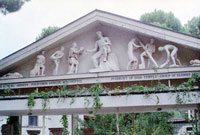 |
|
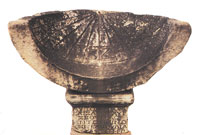 |
|
altars are worth seeing. The sarcophagus dated from the A.D. 2nd century is decarated with Muses. According to the inscription on the lid it was used in the Byzantine period again. And in the west of the garden grave stelae, votive offering stnones are exhibited. The sundial in the center of the garden is the ancient version of the clock tower that decorates the plazas of modern cities. It was discovered in the Tetragonos (Commercial) Agora in Ephesus. |
|
| THE HALL OF TOMBS
In this hall artifacts found in the tombs in and around Ephesus are displayed. On the right hand side on the panel are shown the examples of the tombs and burial types seen in Anatolia. On the left as one enters the hall, ceramics from the Mycenaean Tomb dated back to the 13 and 14 centuries B.C. and excavated in front of the St. John Basilica are displayed. |
|
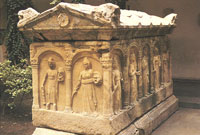 |
|
| The Clazomenain sarcophagus made of clay, in the middle of the hall, was found in the Commercial Agora area. In the hall the grave stelae and osthoteks are also displayed. |
|
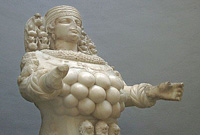 |
|
THE HALL OF ARTEMIS
The most important remains in this gallery are the statues from the Artemis cult of Ephesus. They were found in the Prytaneion. They are dated back to A.D.1st century. The statue on the left is called
"Great Artemis" and the one on the right is called "Beautiful Artemis". |
|
| In the excavations of the Artemision, many offerings made out of gold, silver and ivory were found. Some of these are exhibited in this hall. One of the horse statues of the quatriga ( a chariot drawn by four hourses), which once adorned the Artemision, is displayed here. |
|
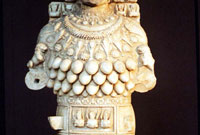 |
|
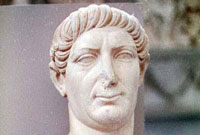 |
|
THE HALL OF THE EMPERORS CULT
In this hall the busts of the emperors and their family members are exhibited. The statue to the right of the entrance belongs to Consul Stefanos. On the left, the original friezes from the Temple of Hadrian are displayed. The altar in the middle is from the Domitian Temple. The altar is decorated with friezes on three sides. |
|
| The head and the hand of the Emperor Domitian are some of the most interesting piece of the hall. Near the far end of the room, the statues of Emperor Augustus and his wife, Livia, and the fragments of the Parthian monument are seen. |
|
 |
|
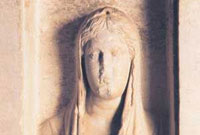 |
|
THE HALL OF THE FUNERARY RELICS
This room opening from the garden displays finds from the gravesites. On the left wall are drawings of Anatolian burial customs. On the left are small artifacts taken from a Mycenian grave in front of St. John's Church dating from the 14th or 13th centuries BC, proving that the history of Ephesus dated from before Androcles. |
|
| In another display case are small glass artifacts taken from graves in and around Ephesus. At the end of the room are numerous stele taken from sarcophagi in the area. |
|
|
 |
|
|
|